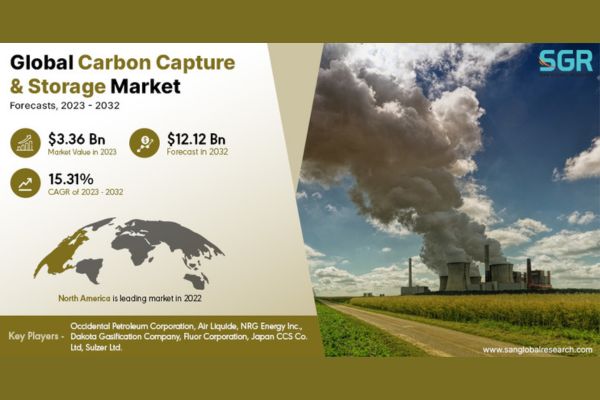According to the new report titled “ Carbon Capture and Storage Market by By Technology (Pre-Combustion Capture, Oxy-fuel Combustion Capture, Post-combustion Capture, Chemical Looping Combustion and Direct Air Capture), By End-user Industries (Oil and Gas, Coal and Biomass Power Plant, Iron and Steel Production, Chemical) Global Analysis to 2023″, the valuation of the Carbon Capture and Storage market was $3.36 Billion in 2023 and is projected to reach $12.12 Billion by 2032, at a CAGR of 15.31% from 2023 to 2032.
The Carbon Capture and Storage Market reached a valuation of $3.36 billion by 2023 and is anticipated to experience a compound annual growth rate (CAGR) of 15.31% over the forecast period. Carbon capture and storage (CCS) and carbon capture, utilization, and storage (CCUS) systems are widely acknowledged for their potential to significantly reduce CO2 emissions. Carbon dioxide (CO2) stands as a primary anthropogenic greenhouse gas (GHG), contributing approximately 76% (38 Gigatonnes (Gt) CO2) to the global GHG emissions in 2010. These emissions stem from various sectors, with energy supply accounting for 35%, agriculture, forestry, and other land use for 24%, industry for 21%, transport for 14%, and buildings for 6%. Despite a 5.8% reduction (almost 2 Gt CO2) in global CO2 emissions in 2020, attributed to decreased coal, oil, and gas demand during the COVID-19 pandemic, energy-related CO2 emissions remained at 31.5 Gt. This led to 2.6 parts per million (ppm) increase in the global annual mean atmospheric CO2 concentration, reaching 412.5 ppm—approximately 50% above pre-industrial levels from 1750. Projections indicate a potential rebound in global energy-related CO2 emissions by almost 5% (1,500 Megatons (Mt) CO2) in 2021 if there is an economic resurgence, with emissions remaining approximately 1.2% (400 Mt CO2) below 2019 levels.
Pre-Combustion to held the largest share in the Carbon Capture and Storage market.
By Technology, the Carbon Capture and Storage Market is segmented into Pre-Combustion Capture, Oxy-fuel Combustion Capture, Post-combustion Capture, Chemical Looping Combustion and Direct Air Capture. Pre-combustion CO2 capture technology has achieved maturity and boasts a history of over 95 years of application in the chemical industry. This method involves capturing carbon dioxide before the combustion of fuel. It finds application in Natural Gas Combined Cycle (NGCC) and Integrated Gasification Combined Cycle (IGCC) power plants, relying on processes established in industrial hydrogen and chemical commodity production. When applied to new IGCC power plants utilizing bituminous coal, the energy requirement for CO2 capture was 10% lower per megawatt-hour (MWh), yet the associated CO2 capture cost was higher by USD 83 per ton of CO2 compared to Supercritical Pulverized Coal (SCPC) power plants without Carbon Capture and Storage (CCS). Notably, research tends to concentrate on pre-combustion CO2 capture in coal-based power generation plants rather than natural gas-based ones, given that the latter’s plant complexity and costs are not competitive with post-combustion CO2 capture in natural gas-based power generation plants.
North America headed the Carbon Capture and Storage market in 2023
North America is emerged as leading market for Carbon Capture and Storage market in 2023. North America stands to benefit significantly from its robust presence in leading end-use industries, fostering a heightened demand for innovative clean technologies and propelling the widespread adoption of carbon capture and storage solutions. Additionally, governmental initiatives within the region underscore a proactive commitment to reducing carbon emissions. Notably, policies such as the executive order championed by President Joe Biden, which aims to achieve 100% carbon-free electricity by 2032, contribute to creating an environment conducive to the expansive growth of the carbon capture and storage market. This forward-thinking approach positions North America as a frontrunner in comparison to other regions. The region’s unwavering dedication to achieving clean energy goals not only reflects its commitment to environmental sustainability but also serves to strengthen its leading role in the carbon capture and storage sector. The emphasis on curtailing carbon emissions and transitioning towards cleaner energy sources further solidifies North America’s preeminent position, making it a pivotal player in shaping the trajectory of the global carbon capture and storage market.
Key market players operating in the market that are profiled in the report are Occidental Petroleum Corporation, Air Liquide, NRG Energy Inc., Dakota Gasification Company, Fluor Corporation, Japan CCS Co. Ltd, Sulzer Ltd. etc.















